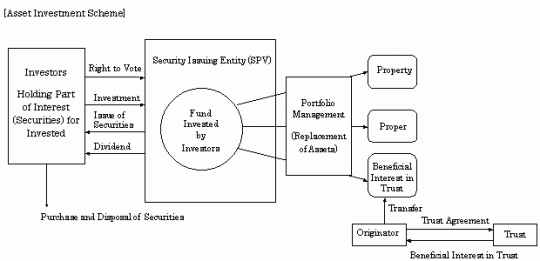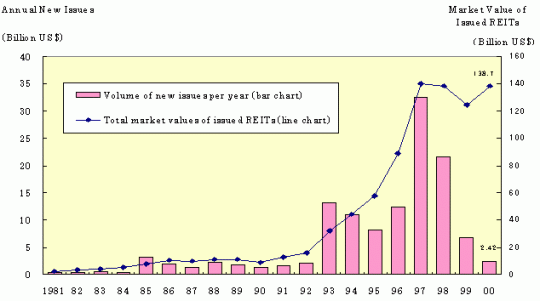Methods of Real Property Securitisation and its Characteristics
1. Methods of Real Property Securitisation
“Real Property Securitisation” is a phrase that is widely used to describe the process of transforming direct ownership of real property, such as land and buildings, into indirect ownership through the investment in marketable securities, while preserving for the investor the benefits of income and revenues generated from the operation and sale of such real property. “Real-property-securitised products” are the securities that represent ownership interests in real property which investors receive in real property securitisation.
The different forms of real property securitisation can be broadly categorised into two main types – the “Asset Liquidation Scheme” and “Asset Investment Scheme” (see Chart 5).
Chart 5 Structure of Real Property Securitisation

Source: prepared by Ministry of Land, Infrastructure and Transport based on the “First Interim Report” by the First Subcommittee of the Financial System Council
- An “Asset Liquidation Scheme” involves the following: Identified real property and other assets are transferred to a vehicle which issues negotiable instruments supported by income from the real property and other assets. These negotiable instruments are then sold to investors to raise funds. The scheme based on the so-called SPC Act (“Law on Securitisation of Specified Assets by Special Purpose Companies”, currently the “Law Concerning Asset Liquidation”) enacted in 1998 is included in this category;
- An “Asset Investment Scheme” involves the following: An investment fund is established by issuing negotiable instruments to raise funds from investors. The investment fund then invests those funds in real property of an identified type chosen by the fund managers. Schemes such as the Real Estate Investment Trust and the Real Estate Investment Corporation, so-called Property Investment Funds, based on the “Law Concerning Investment Trusts and Investment Corporations” enacted in November 2000 fall under this type of approach. Currently, the “Asset Investment Scheme” is under development. As of the end of March 2001, securitisation based on this scheme is almost but not quite ready to commence trading (note: Securitisation based on “Asset Investment Scheme” was started in September, and two Property Investment Funds (so called J-REITs) were listed at Tokyo Stock Exchange as of 10th September 2001). In the United States, one of the most common real-property-securitised products is the REIT (“real estate investment trust”), which falls under the “Asset Investment Scheme”. REITs have a large market share in the United States, with the total issued market value of REITs amounting to US$ 140 billion (see Chart 6); and
- The Real Estate Syndication Business, based on the “Real Estate Syndication Act” enacted in 1995, is not a real property securitisation product in the strict sense, since investors hold a percentage of the direct interest in real property instead of security, but has some similar features and benefits of real property securitisation. As a method for selling real property interests in small, defined units, products based on both the “Asset Liquidation Scheme” and the “Asset Investment Scheme” are available to serve the Real Estate Syndication Business.
2. Characteristics of Real Property Securitisation
Real property securitisation, compared to direct investment in real property, has the following characteristics:
- Liquidity (conversion to cash) is enhanced, since the interest which investors hold is in the form of negotiable securities;
- Securitisation is a structure under which a series of small funds can be collected from multiple investors resulting in a large overall investment. Direct property investment, which generally requires more substantial funds, can be made by collecting smaller funds and pooling them;
- Since management of the subject properties is delegated to experts, investors do not have to be involved in property management. Under the “Asset Investment Scheme” not only property management of the subject properties but also the decision making regarding the actual investment in individual properties is commissioned to corporations that have expertise in these areas. As a result, it is much easier for individual investors, even with little experience in property investment and management, to participate in these investments;
- By delegating property management to experts and by making use of financial techniques to structure the securitisation, risks should be decreased to some degree; and
- Some of the above benefits are off-set by the costs, expenses and fees associated with the establishment of real-property-securitised products. Returns from securitised products, compared with direct investment in real property under the same conditions, will be lower as risks are decreased.
Chart 6 Trends of Total Market Values of Listed REITs and Values of New Issues by Issued Year (US)

Source: prepared by Ministry of Land, Infrastructure and Transport based on “Property Securitisation Handbook” by the Council for Real Estate Syndication
3. Characteristics of Real-Property-Securitised Products
Real-property-securitised products can be established as mid-risk/mid-return. Steady income streams generated by the underlying real property will moderate the risks associated with fluctuations in real property valuations. Also, real property values tend not to correlate directly with stock market fluctuations.
Thus, once the risks of the products are fully understood, real-property-securitised products can be used for investment diversification to reduce market risks in an investors’ portfolio.
